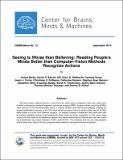Seeing is Worse than Believing: Reading People’s Minds Better than Computer-Vision Methods Recognize Actions
| dc.contributor.author | Barbu, Andrei | |
| dc.contributor.author | Barrett, Daniel P. | |
| dc.contributor.author | Chen, Wei | |
| dc.contributor.author | Narayanaswamy, Siddharth | |
| dc.contributor.author | Xiong, Caiming | |
| dc.contributor.author | Corso, Jason J. | |
| dc.contributor.author | Fellbaum, Christiane D. | |
| dc.contributor.author | Hanson, Catherine | |
| dc.contributor.author | Hanson, Stephen Jose | |
| dc.contributor.author | Helie, Sebastien | |
| dc.contributor.author | Malaia, Evguenia | |
| dc.contributor.author | Pearlmutter, Barak A. | |
| dc.contributor.author | Siskind, Jeffrey Mark | |
| dc.contributor.author | Talavage, Thomas Michael | |
| dc.contributor.author | Wilbur, Ronnie B. | |
| dc.date.accessioned | 2015-12-10T19:07:10Z | |
| dc.date.available | 2015-12-10T19:07:10Z | |
| dc.date.issued | 2015-12-10 | |
| dc.identifier.uri | http://hdl.handle.net/1721.1/100176 | |
| dc.description.abstract | We had human subjects perform a one-out-of-six class action recognition task from video stimuli while undergoing functional magnetic resonance imaging (fMRI). Support-vector machines (SVMs) were trained on the recovered brain scans to classify actions observed during imaging, yielding average classification accuracy of 69.73% when tested on scans from the same subject and of 34.80% when tested on scans from different subjects. An apples-to-apples comparison was performed with all publicly available software that implements state-of-the-art action recognition on the same video corpus with the same cross-validation regimen and same partitioning into training and test sets, yielding classification accuracies between 31.25% and 52.34%. This indicates that one can read people’s minds better than state-of-the-art computer-vision methods can perform action recognition. | en_US |
| dc.description.sponsorship | This work was supported, in part, by the Center for Brains, Minds and Machines (CBMM), funded by NSF STC award CCF - 1231216. AB, DPB, NS, and JMS were supported, in part, by Army Research Laboratory (ARL) Cooperative Agreement W911NF-10-2-0060, AB, in part, by the Center forBrains, Minds and Machines (CBMM), funded by NSF STC award CCF-1231216, WC, CX, and JJC, in part, by ARL Cooperative Agreement W911NF-10-2-0062 and NSF CAREER grant IIS-0845282, CDF, in part, by NSF grant CNS-0855157, CH and SJH, in part, by the McDonnell Foundation, and BAP, in part, by Science Foundation Ireland grant 09/IN.1/I2637. | en_US |
| dc.language.iso | en_US | en_US |
| dc.relation.ispartofseries | CBMM Memo Series;012 | |
| dc.rights | Attribution-NonCommercial 3.0 United States | * |
| dc.rights.uri | http://creativecommons.org/licenses/by-nc/3.0/us/ | * |
| dc.subject | Object Recognition | en_US |
| dc.subject | Vision | en_US |
| dc.subject | Support-Vector Machines (SVMs) | en_US |
| dc.title | Seeing is Worse than Believing: Reading People’s Minds Better than Computer-Vision Methods Recognize Actions | en_US |
| dc.type | Technical Report | en_US |
| dc.type | Working Paper | en_US |
| dc.type | Other | en_US |
